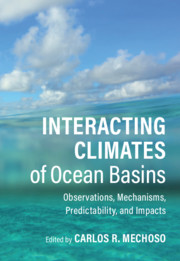Book contents
- Interacting Climates of Ocean Basins
- Interacting Climates of Ocean Basins
- Copyright page
- Contents
- Contributors
- Preface
- 1 Variability of the Oceans
- 2 Teleconnections in the Atmosphere
- 3 Atmosphere–Ocean Interactions
- 4 Interacting Interannual Variability of the Pacific and Atlantic Oceans
- 5 Indian Ocean Variability and Interactions
- 6 The Arctic Mediterranean
- 7 Combined Oceanic Influences on Continental Climates
- 8 Basin Interactions and Predictability
- 9 Climate Change and Impacts on Variability and Interactions
- Index
- References
3 - Atmosphere–Ocean Interactions
Published online by Cambridge University Press: 13 January 2021
- Interacting Climates of Ocean Basins
- Interacting Climates of Ocean Basins
- Copyright page
- Contents
- Contributors
- Preface
- 1 Variability of the Oceans
- 2 Teleconnections in the Atmosphere
- 3 Atmosphere–Ocean Interactions
- 4 Interacting Interannual Variability of the Pacific and Atlantic Oceans
- 5 Indian Ocean Variability and Interactions
- 6 The Arctic Mediterranean
- 7 Combined Oceanic Influences on Continental Climates
- 8 Basin Interactions and Predictability
- 9 Climate Change and Impacts on Variability and Interactions
- Index
- References
Summary
This chapter presents a conceptual discussion on how ocean–atmosphere interactions are key to outstanding aspects of climate variability. The principal goal is to describe the mechanisms by which the atmosphere and ocean interact, and their perturbation feedback on each other, as well as how these interactions can lead to a new breed of modes in the coupled ocean–atmosphere system. The realization of such local interactions can project onto basin scales, and subsequently to the other basins.
- Type
- Chapter
- Information
- Interacting Climates of Ocean BasinsObservations, Mechanisms, Predictability, and Impacts, pp. 89 - 119Publisher: Cambridge University PressPrint publication year: 2020
References
- 2
- Cited by



